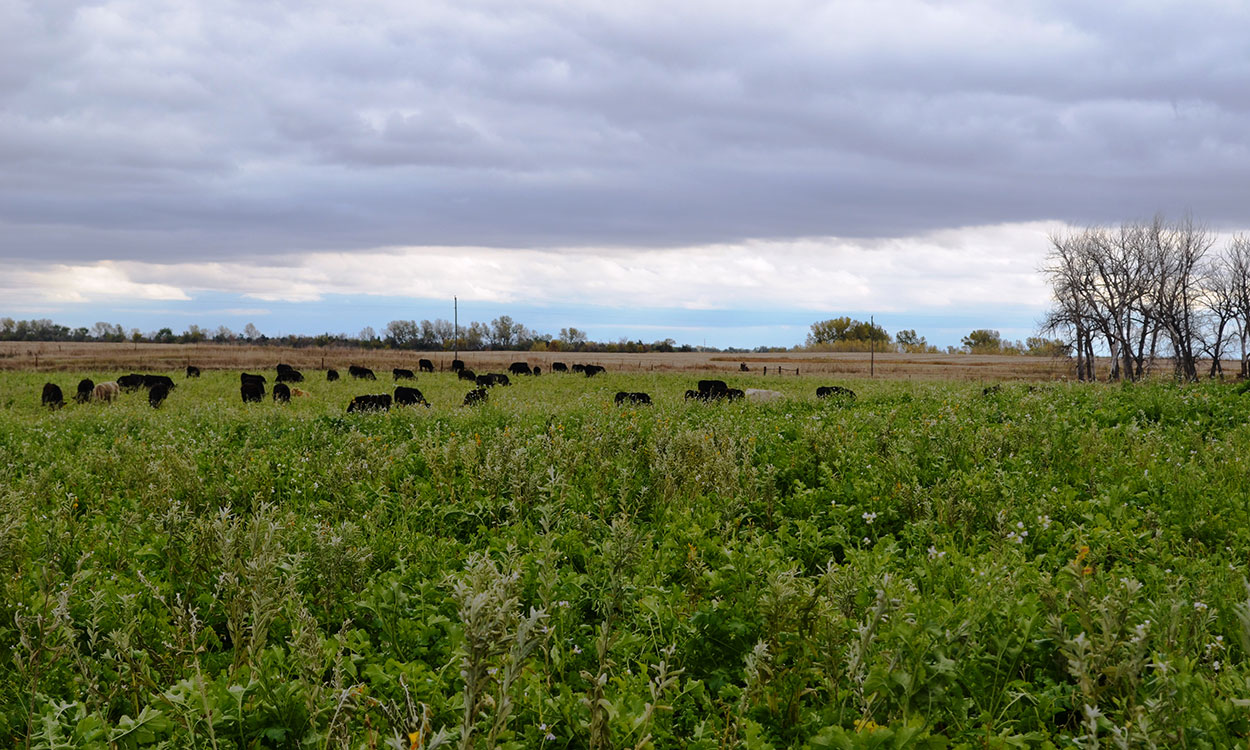
Continuous grazing, which allows livestock unlimited access to grassland of the whole ranch, is the dominant practice in the Great Plains. When livestock graze large pastures, they tend to graze preferred plants repeatedly, leaving other plants lightly utilized or totally avoided. Such selective grazing behavior is common, which causes a decline in desirable grass species, an increase in less palatable grasses as well as bare ground, and progressively leads to degradation of the landscape (Teague et al., 2004; 2013).
Rotational grazing moves livestock herds through several paddocks, with only one paddock being grazed at a time. Compared to continuous grazing, rotational grazing allows more time for defoliated grasses to recover, which is necessary to minimize overgrazing and to restore degraded ecosystem functionality. By minimizing selective grazing behavior, rotational grazing increases efficiency in forage utilization and therefore allows for greater stocking capacity (Wang et al., 2018).
Rotational Grazing Adoption Rate Stagnating in Recent Years

Despite the potential benefits of rotational grazing, its adoption rate has stagnated in recent years (Wang et al., 2020). To help understand major barriers faced by producers towards rotational grazing, we conducted a survey among ranchers in the U.S. Great Plains, with 1,500 ranchers each randomly selected from North Dakota, South Dakota and Texas respectively. From the Dakotas, we received 549 completed questionnaires of which 356 respondents (65%) identified themselves as rotational grazing adopters. Figure 1 divides RG adopters into four categories based on their adoption years. We can see that the majority of adopters (52.1%) indicated that they have implemented rotational grazing practice for 20 years or more. The number of adopters declines for categories with fewer adoption years, with only 4.9% indicated that they adopted rotational grazing practice within the recent 5 years. The low uptake rate in recent years suggests relatively low interest in rotational grazing practices among non-adopters.
Potential Barriers for Rotational Grazing
Producers were asked to rate some potential barriers they face while implementing rotational grazing practice. As indicated in Table 1, we divided these barriers into three major categories: 1) cost and labor constraints; 2) ranch condition constraints; and 3) knowledge and perception constraints. For each of the barriers listed in Table 1, respondents could choose from one of the five options, where 1= not a challenge, 2 = minor challenge, 3 = some challenge, 4 = quite a challenge and 5 = great challenge.
| Category | Variable | Description |
|---|---|---|
| Cost/Labor Constraints | Cost | High installation cost |
| Cost/Labor Constraints | Cash | Cash flow constraints |
| Cost/Labor Constraints | Labor | Labor/management time constraints |
| Ranch Condition Constraints | Water | Water source constraint |
| Ranch Condition Constraints | Weather | Weather/climate factors |
| Ranch Condition Constraints | Lease | Lease Agreement restrictions |
| Knowledge/ Perception Constraints | LackInfo | Lack of information/education/support |
| Knowledge/ Perception Constraints | Uncertain | Uncertain Outcomes |
| Knowledge/ Perception Constraints | Leadership | Unwillingness to take on leadership in new practices |
| Knowledge/ Perception Constraints | Neighbor | Unfavorable neighborhood opinions |
Top Barriers Identified by Non-Adopters in the Dakotas

Figure 2 demonstrates average ratings of different barriers, using survey data provided by adopters and non-adopters in the Dakotas.
For non-adopters, we can see that water source and labor constraints were perceived as the top two most important barriers, both with average ratings greater than 3.5. This means the majority of ranchers regarded these two barriers as ‘quite a challenge’ or ‘great challenge’.
High installation cost was ranked as the third most challenging issue for the non-adopters, with an average rating of 3.37. This suggests that while cost-sharing might motivate some ranchers to adopt the practice, its effect could be limited if more important barriers such as water source and labor constraints were not adequately addressed.
Perceived Barriers Contingent on Adoption Status and Ranch Characteristics
Figure 2 illustrates that adoption status made a difference on perceived barriers. Compared to non-adopters, adopters generally considered the listed barriers as less challenging. For example, adopters were less likely to perceive uncertain outcomes as a challenge, which implies they generally know what to expect after implementing the practice for some time. Additionally, the perceived challenging levels for labor and cost constraints were significantly reduced. For adopters, the only barrier that has an average rating greater than 3 (some challenge) was water resource constraint.
Other than adoption status, our findings also showed that producer perceived challenges were also influenced by factors such as soil quality, cropland share and ownership status (Wang et al., 2020). Specifically, we found that non-adopters with better quality soil, more owned land and a higher proportion of grazing land tend to perceive the barriers listed in Figure 2 as less challenging. Producers with such characteristics, therefore, may be a suitable target group for more effective outreach efforts, so that they can weigh benefits of rotational grazing against its barriers and make more informed decisions.
Acknowledgements: This article is based upon research work that is financially supported by the National Institute of Food and Agriculture, U.S. Department of Agriculture, under award number 2017-67024-26279.
References:
- Teague, R., Provenza, F., Kreuter, U., Steffens, T., & Barnes, M. (2013). Multi-paddock grazing on rangelands: why the perceptual dichotomy between research results and rancher experience? Journal of Environmental management, 128, 699-717.
- Teague, W. R., Dowhower, S. L., & Waggoner, J. A. (2004). Drought and grazing patch dynamics under different grazing management. Journal of Arid Environments, 58(1), 97-117.
- Wang, T., Jin, H., Kreuter, U., Feng, H., Hennessy, D. A., Teague, R., & Che, Y. (2020). Challenges for rotational grazing practice: Views from non-adopters across the Great Plains, USA. Journal of Environmental Management, 256, 109941.
- Wang, T., Teague, W. R., Park, S. C., & Bevers, S. (2018). Evaluating long-term economic and ecological consequences of continuous and multi-paddock grazing-a modeling approach. Agricultural Systems, 165, 197-207.


